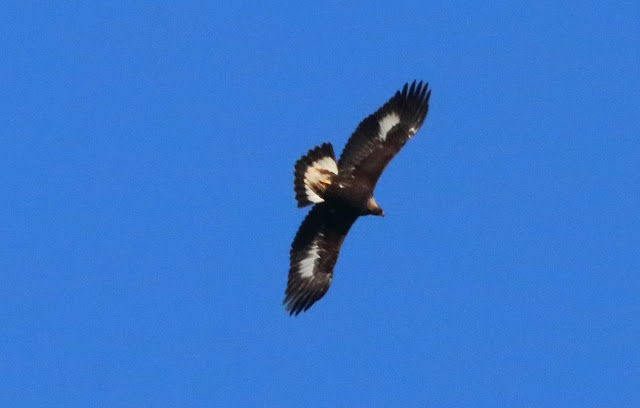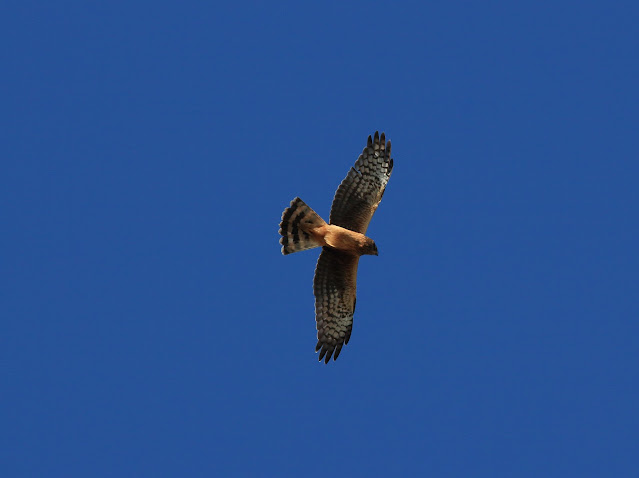WAGGONER'S GAP HAWK WATCH
CAPRIVI, PENNSYLVANIA
1-3 November 2024
Common Raven overhead. This species passes by regularly each day in ones, two, or threes.
Every autumn I struggle to choose a set of days for visiting Waggoner's Gap Hawkwatch that will produce the best encounters with passing raptors. I do lots of back-of-the-envelope analysis based on winds and past bird lists from these dates from years past. I want to be on the Rocks when good numbers of Golden Eagles pass by, ideally at close range to permit me to get pretty images of these magnificent creatures. Also, at this time of year, there is also hope for the occasional American Goshawk (a bird that has become every more uncommon decade by decade). If a good northwest wind blows steadily in excess of 12 MPH, the raptors may stream through, making everybody giddy and grateful.
 Adult Bald Eagle soars on the north side, with the autumn ridges providing a pretty background.
Adult Bald Eagle soars on the north side, with the autumn ridges providing a pretty background. In fact, the greatest joys of the hawkwatch are invariably: (1) the tranquil time spent in a particularly beautiful spot in Nature, and (2) the happy and knowledgeable fellowship of hawk-watchers who share the Rocks with me. These two pleasures are always guaranteed, even on a day when the raptors are few and distant.
It's always nice to be able to gaze downward on passing birds, such as this Turkey Vulture...
Also getting to spend some quality time in the charming town of nearby Carlisle, PA, is a plus. Restaurants like Issei Noodle and Yak and Yeti are always interesting. Starting the morning with hot coffee and a fortifying old-fashined breakfast at Carlisle Diner is also a winner.

This November, as we rapidly approached the most nerve-racking election in history, the winds were too feeble and too unsteady to generate much in the way of raptors. All my analysis and planning were for naught. It seems the cold fronts that produce strong northwest winds required by the raptors simply are not being generated by our current autumn climate. This very same complaint can be heard at Cape May, New Jersey, another raptor migration site that I like to visit in autumn (see preceding blog). The weather patterns are changing, thanks to a changing world.
A pair of resident adult Bald Eagles pass by the hawkwatch rocks. These birds, as with the ravens, move back and forth along the ridge each day, teasing the hawk-watchers, who count only "migrating" birds (here birds that pass steadily from
northeast to southwest of the Rocks). A young Dark-eyed Junco comes to the rocks for the proffered birdseed put out by the Hawkwatch. These visiting juncos, chickadees, and nuthatches offer amusement when the raptors are slow...
The Hawk-watchers also watch the passing songbirds. Some, like this junco come and visit the rocks. Others, such as siskins, Purple Finches, American Robins, Eastern Bluebirds, and Blue Jays, pass by in flocks, on their way to their wintering places.
A juvenile Bald Eagle approaching the Hawkwatch gets attention, with hopes it may in fact turn into a Golden Eagle...
I want to tip my hat to the dedicated counters, who spend long hours on the Rocks, often many days each month. These folks are counting raptors from sunrise to sunset, often facing inclement weather: fog, rain, still and overly-warm bluebird days. They hang in there day-in, day-out. Brandon Brogle is the official Waggoner's Gap raptor counter. He is young, eagle-eyed, and perfectly suited to this difficult task from early September to early December. He uploads the observations to the HMANA Hawk Count website in real time each day, so that we all can peek in from afar to see what is happening up there on the Rocks. He is ably aided by a suite of volunteer hawk-watchers, most of whom have decades of tenure up here on the Rocks. Dave Grove, I believe, is the seniormost Watcher. He can clearly recall November 7th 1999 when 29 American Goshawks and 26 Golden Eagles passed close by, making it the the best late-autumn day ever experienced here. I address Dave when I want to know something technical about the science of hawk migration. He is often accompanied by Ron Freed, Gene Wagner, and Paul Fritz, who are also fonts of knowledge of the Rocks and its history of hawk-watching (and of hawk watching nationally). Additional faithful and dedicated watchers I have had the pleasure of spending time with include Deb Gingrich, Pat Freed, Elizabeth Zink, Meredith Lombard, Pete Biasucci, Joe Yoder, Jeff Thompson, and Glenn Mitzel. I salute them all!

waterbirds such as geese, swans, cormorants, and loons pass high overhead... (here Canada Geese)
Close-up of a juvenile Bald Eagle passing....
Yellowing leaves of a coppicing American Chestnut at the base of the Rocks. This tree produced nuts
before dying back from the blight. These surviving chestnuts remind us of the devastating blight that killed
more than 4 billion adult trees from Maine to Mississippi. The once was "America's Tree."
Here is another eagle, apparently a young Bald.
Here is a subadult Golden Eagle being attended by a Common Raven. This is at medium distance.
Here is a subadult Golden Eagle at close range (2021). We all hoped for birds like this during my 3 days in 2024: no luck.
Another 2021 Golden--a striking juvenile. This is the raptorial payoff we all hope for when visiting the Rocks in November.
We had several Northern Harriers during this visit, but none this close (image from 2022).
Several Cooper's Hawks passed by, but none as close as this (here an image from Cape May, 2018).
Here is a Merlin at close range. Our birds this year were all distant and difficult to photograph.
Adult Sharp-shinned Hawk. One of the dominant species passing the Hawkwatch each year.
Ventral view of an adult Sharp-shinned Hawk, note the distinctly squared-off tail.
A young Red-tailed Hawk, the most common raptor in early November.
Here is a Golden Eagle binoculars view that is typical from the Rocks. Many birds pass by at great distance.
For those contemplating a visit to watch raptor migration for the first time at Waggoner's Gap, I want to offer some advice. First, look at the image just above. Many of the raptors pass by at considerable distance and offer only a few pixels on the camera sensor. It can be a shock how distant most passing birds are--eagle are often spied 3-4 miles north of the Rocks. They are just dark specks in the binoculars. Also, the Rocks can be exposed and chilly, so watchers need to over-dress in layers that can be added or subtracted based on changing conditions. Bring pillows to sit on. Bring plenty of snacks and drinks to keep you going. 8 hours on the rocks can be quite challenging to those not adequately prepared. Bring sunscreen and sunglasses and a hat. And be prepared to be entertained by the group on the Rocks--people who are smart, knowledgeable, and funny.
Only the Turkey Vultures and ravens pass by at close range on a regular basis.Here is the list of raptors observed by the Hawkwatch on the days I was there (1-3 Nov 2024). The number with each species is the highest day-count for each: Black Vulture (various nonmigrants), Turkey Vulture (26), Merlin (2), Sharp-shinned Hawk (14), Cooper's Hawk (8), American Goshawk (1), Red-tailed Hawk (65), Red-shouldered Hawk (12), Northern Harrier (3), Bald Eagle (15), Golden Eagle (5). The three-day total of Golden Eagles was 8 birds. This is low for this time of year and probably reflects the lack of strong cold fronts and the lack of cold weather that would drive the birds southward from their post-breeding loafing sites in the Northeast... As the autumn and winter ameliorates, fewer Goldens will venture south, because they can happily subsist in New England on the gut-piles that deer hunters leave in fields as well as small game such as Snowshoe Hares.























Have You Ever Been A Victim to Scam⁉️
ReplyDeleteHere Is What You Need To Do❗❕
Contact PYTHONAX Immediately✔
🔥 PYTHONAX are individuals that uses their skill in computing science to track down scammers using transactions records and communications contacts.
If you have been a victim of any of this scam listed, you need to contact PYTHONAX-;
❌Cryptocurrency investments scams.
❌Buying and Selling scams.
❌Romance & Dating Scams.
❌Loan or Grant Scams. E.t.c.......
📢 We do not require your personal information, You can remain anonymous when contacting us. We only want to help you get your money back, a few info would be required from you and if you can provide this info, we will do everything we can to help you.
ℹ You need to understand that scammers are very careful when spending money they got from scamming people, the money has to be well cleaned and pass through a business in order for them to be able to put it in a bank account.
⚠️ Beware of individuals who impersonate us, and post false testimonials online or comment to lure you to them. We do not report or share stories of jobs we have done or taken. We keep info of every client discreet.
📧 Contact PYTHONAX today using the emails below-:
Pythonaxhelp@protonmail.com
Pythonaxservices@protonmail.com